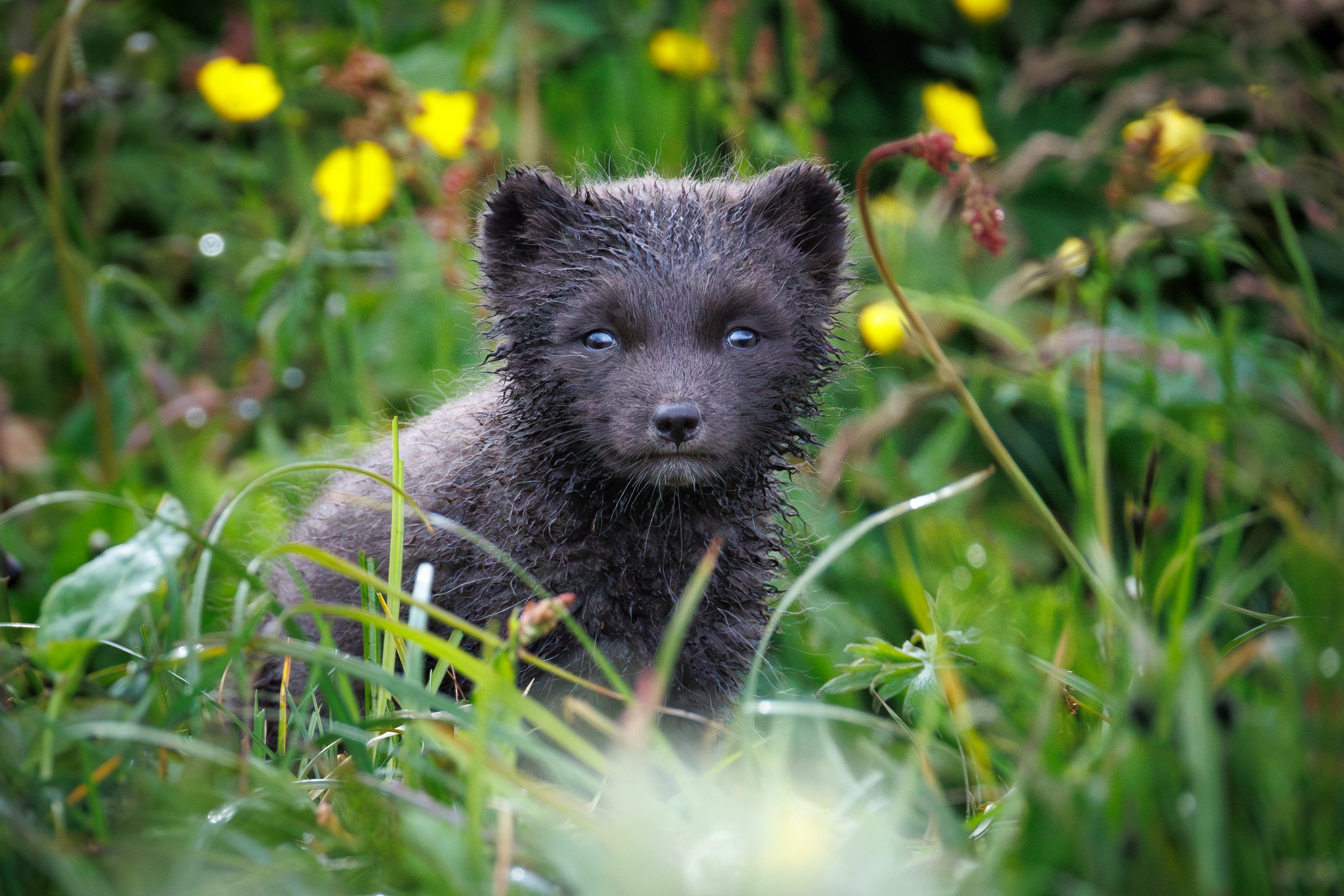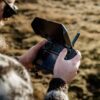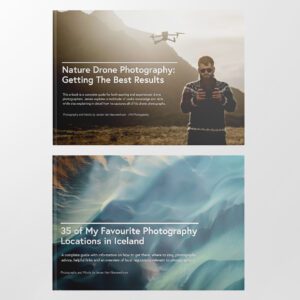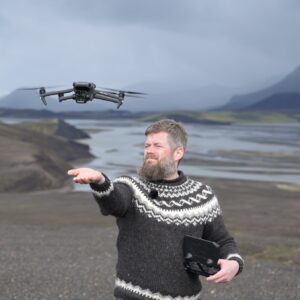The Arctic Fox has always held a special place in my heart. I absolutely love photographing them as they make for incredibly cute photography subjects. This year, I hosted the very first edition of my Arctic Foxes in Hornstrandir photo workshop, during which I set out with a group of photographers to focus on finding and photographing arctic foxes. It was an incredible experience to be out in one of the most remote corners of Iceland, with the arctic foxes being the only other living creatures inside of the valley we stayed in. It’s a huge learning experience for the workshop participants, who got to understand the habits of the arctic fox but also learned how to improve their wildlife photography.
And also for me it was a huge learning experience because during this photo workshop, I decided to try out the Canon RF 200-800mm F6.3-9 IS USM lens, which is one of the newer additions to Canon’s superzoom line-up. While I use zoom lenses a lot, I had never used a dedicated zoom lens with such a long range. I tested the Canon RF 200-800mm F6.3-9 IS USM for the entire week during the photo workshop in combination with a range of extenders and my Canon EOS R5 Mark II. How did I get one with it? You can find out in this review on the Canon RF 200-800mm F6.3-9 IS USM!
Interested in joining me on my next Arctic Fox adventure in July 2026? I have now opened for bookings on the 2026 edition of my Arctic Foxes in Hornstrandir photography workshop!
Full disclosure: This is not a sponsored review. I borrowed the Canon RF 200-800mm F6.3-9 IS USM for a week from Ofar/Canon Iceland and used it during my Arctic Foxes in Hornstrandir photo workshop. I am not being paid to write this review nor did anyone get any input or preview. All opinions are my own.
But… Before I delve into the review part of this blog, I want to share a few words about the photo workshop during which I tested the Canon RF 200-800mm F6.3-9 IS USM telephoto lens.
Photo Workshop Report: Arctic Foxes in Hornstrandir
This year, I hosted an arctic fox focused photo workshop in Hornstrandir for the very first time. While I have been to the Hornstrandir Nature Reserve on my own time, especially to photograph the arctic foxes, it was the first time I took one of my photography groups to the area. Hornstrandir is a challenging to run photography workshops as it is one of the most remote areas in Iceland, only reachable by boat. To get the best possible experience for the workshop, I organised for us to stay in a remote house in a part of the nature reserve that is not even frequented by hikers visiting the area.
Following a brief detour to focus on finding & photographing whales, we were dropped off on the beach at Kvíar, an old house, which would be our base of operations for the week. After settling in & getting familiar with the quaint house, we set out on a first reconnaissance hike. Not long after we set off, I began hearing an arctic fox calling. While the sound was initially very distant, the sound approached us slowly but surely. Sure enough, after staying put for a while, we spotted an adult fox running around an area filled with big boulders. The arctic fox wasn’t particularly interested in us as he/she seemed to be scavenging for food and ran higher & higher up the mountain doing so, giving us only a glimpse at the wildlife we were there to photograph.
But, little did we know, this was just a small taste of things to come…
The following days, things just got better & better as the photo workshop progressed. On our first full day, we started off with finding an arctic fox scavenging for clams & other juicy seafood on the beach down from our house. The arctic fox was completely indifferent of our presence and ran past us multiple times in search of food, allowing us to capture incredible close-up images.
Later that day, we began noticing a lot of arctic fox activity near the back of the house. At first it wasn’t so obvious but sure enough, we began seeing trails formed by the arctic foxes coming & going, indicating they had dug a huge den near the house. On the second day, after having gone through the daily image critique session, we were lucky enough to spot one of the arctic fox cubs sitting outside of its den. This cute little cub had become brave enough to venture outside of the safety of its den. It was amazing to think we were probably the first humans it ever laid eyes on.
And this newfound bravery quickly spiraled out of control. The next days, we began seeing more & more cubs exit the same den but they also began running around the house, becoming more & more playful. While we had always tried to keep our distance from the den and the cubs, to give them much needed space, the cubs themselves began approaching us to satisfy their curiosity. This evidently resulted in everyone getting incredible photographs of all these beautiful encounters.
On top of all these amazing encounters, I enjoyed seeing how each participant dramatically improved their photographs & editing techniques thanks to the daily image critique sessions during this photo workshop. The whole purpose of these critique sessions, filled with helpful & constructive feedback, is to ensure everyone gets to go home with incredible images.
What I Loved About The Canon RF 200-800mm F6.3-9 IS USM
And now, onto my thoughts of the Canon RF 200-800mm F6.3-9 IS USM telephoto lens. As mentioned before, I almost exclusively used the Canon RF 200-800mm F6.3-9 IS USM for the entire photo workshop. I used it in combination with my Canon EOS R5 Mark II, the 1.4x RF extender and the 2x RF extender.
As always, in my lens and camera reviews I don’t obsess about the technical specifications but I rather focus on capturing images I want to capture. I focus on how it performs in-the-field and whether or not it allowed me to do things I would otherwise not be able to do. Do not expect me to be comparing images at 400% crop to check sharpness as I do not believe that’s important at all. The main question that drives me is as follows: does the Canon RF 200-800mm F6.3-9 IS USM telephoto lens allow me to get great images?
The first benefit of using the Canon RF 200-800mm F6.3-9 IS USM is the incredible range it offers. Having a range from 200mm to 800mm is an incredible luxury when trying to photograph wildlife that is easily startled such as small mammals and small birds. The fact you can achieve focal lengths up to 800mm without needing a teleconverter, gives you a crazy amount of flexibility in the field. Even if the subject suddenly moves closer, you can pair back to 200mm. If you then also pair up this lens with a high megapixel camera, such as the Canon EOS R5 Mark II, you have a great combination for your wildlife needs in good light.
Additionally, it is welcome how relatively lightweight it is. Coming in at 2050 gram, it is surprisingly light considering how long of a focal length you are getting. This is especially true when you compare it to more expensive lenses with wider apertures. I find this a particularly important specification as I often encounter people on workshops who are overburdened with heavy lenses and are therefore not able to hike very far, missing shots in the process.
The image stabilisation on the Canon RF 200-800mm F6.3-9 IS USM is great and you can expect about 5,5 stops of compensation, which together with IBIS can make a world of difference at the longest focal length. As with most Canon RF lenses, the Control Ring can double as either a focus ring or a Control Ring (configurable in the camera menu).
Finally, during my testing I have found that the image quality is good. Images are sufficiently sharp, even in combination with the 1.4x RF Extender and the 2x RF extender I used. That said, depending on how close you are to your subject, atmospheric haze can start to pose issues when you shoot into the distance with a focal length of 800mm.
Finally, to demonstrate the image quality you can expect, I prefer to let the images I captured on this photo workshop speak for themselves.
What I Wish Was Better About The Canon RF 200-800mm F6.3-9 IS USM
Of course, no piece of photography gear is ever perfect and the Canon RF 200-800mm F6.3-9 IS USM is certainly no exception here. And that is definitely not a surprise because despite it having the appearance of an L lens (white colour), the Canon RF 200-800mm F6.3-9 IS USM is not part of Canon’s professional L series of lenses.
The biggest disappointment I had during my testing was that I experienced a pretty bad condensation problem. After having been out shooting in rather heavy rain for about an hour, I went back into our accommodation to get warm. As always, I wiped off and dried my camera gear immediately and left my camera bag open to dry. About 20 minutes later, a small little arctic fox cub appeared right outside of the house. I grabbed my camera and as I switched it on, I noticed my lens was completely fogged up. Not just on the outside but also on the inside of the lens. Not only did I miss the shot but the lens didn’t dry out until at least 3 hours later. Disappointing to say the least. While this lens does have some degree of weathersealing, it doesn’t seem to be up to par to handle extended use outdoors. Of course, I have no idea whether this was completely normal or whether the test copy I used of the Canon RF 200-800mm F6.3-9 IS USM was faulty or not but it is something that caused me some headaches during this trip. It is of course also possible that I am simply used to the brilliantly built Canon RF 100-500mm lens, with which I have never had such issues.
Another compromise with the Canon RF 200-800mm F6.3-9 IS USM is of course that you have a rather narrow aperture at the longest focal length. Add a 2x RF Extender to the mix and your aperture drops down to F18, which is very narrow. While I did managed to get several shots with such a narrow aperture, it is good to note that it only really worked on bright days where there is sunlight aplenty.
A minor annoyance is one with the focus ring. This may only bother a small number of people but if you tend to use manual focus, it is good to know that there is no dedicated focus ring. This means will have to get by using the thinner Control Ring, which doubles as a focus ring depending on how you configure the toggle on the side of the lens. Because it is a much thinner ring than focus rings traditionally are, it may not be super practical for you to use.
Finally, if you are like me and you are a user of the Canon RF 100-500mm, you may be a bit disappointed with two aspects of this the Canon RF 200-800mm F6.3-9 IS USM: the autofocus & sharpness. While the autofocus and sharpness aren’t bad, I did find them to be quite a large step down from the Canon RF 100-500m. Firstly, the Canon RF 100-500m focuses considerably faster thanks to its dual focusing motors. At first I thought that wouldn’t be so noticeable but, especially in Servo AF, I notice a massive difference in focusing speed when subjects are closer than usual as was the case with the arctic foxes. I suspect that when you simply want more range, for example in bird photography, you may not find it that big of an issue. In terms of sharpness, I did find the Canon RF 100-500m a bit sharper overall, which mostly presented itself in details in the fur.
But why have I repeatedly compared the Canon RF 200-800mm F6.3-9 IS USM with the Canon RF 100-500m in this review? There is a simple answer to that: price. With only a small difference in price (roughly 500USD at the time of writing), these two lenses are very comparable. For that reason, I am less forgiving about the fact that the Canon RF 200-800mm F6.3-9 IS USM is an inferior lens in some critical aspects such as weather-sealing, focusing speed & image sharpness – even though you get the extra range.
Conclusion: Should You Get The Canon RF 200-800mm F6.3-9 IS USM?
While the Canon RF 200-800mm F6.3-9 IS USM is a solid lens, it isn’t exceptional to me. If this would have been a lens with Canon’s L-level of quality, it could have been a slam dunk – even if it came in at a higher price point. My main gripe is that I can’t rid myself of the feeling that there is a better option available within the range of Canon lenses – while only being slightly more expensive: the Canon RF 100-500mm. To me, it all boils down to how important that extra 300mm of range is without needing a teleconverter. If that is the key factor to you: the Canon RF 200-800mm F6.3-9 IS USM is the lens to get.
Discover Jeroen’s Photo Workshops in Iceland, Greenland & Beyond
Ready to take your photography to the next level? Join me, Jeroen Van Nieuwenhove, on unforgettable photo workshops in Iceland, Greenland, Antarctica and other exciting destinations. Whether your passion is wildlife photography, bird photography, landscape adventures, or mastering drone photography, each workshop is designed to give you hands-on guidance in some of the world’s most spectacular locations.
From puffins in the midnight sun to Arctic foxes in the wild, from glaciers and volcanoes to dramatic coastlines seen by drone – these journeys are more than workshops; they’re once-in-a-lifetime experiences. Group sizes are kept small, ensuring personal mentoring and plenty of shooting opportunities.
Looking for something specific? Check out Jeroen’s…
- Wildlife & Bird Photography Workshops (Puffins, Arctic Foxes)
- Drone Photography Workshops
- Photo Workshops in Iceland
- Photo Workshops in Greenland
Spots are limited – secure your place today!
What Previous Participants Shared About Their Experience
These reviews are verifiable on Jeroen’s public Google Business profile.
Support Jeroen’s Work
As an independent photographer, Jeroen partially relies on your support to keep producing worthwhile content such as blogs, photographs, books and much more. If you want to support his work, it is possible to do so by buying his e-books & books, prints or calendars.
You can also sign up to the newsletter to stay up to date on new blog posts, projects, workshops and other interesting information.
Thank you for considering!


































